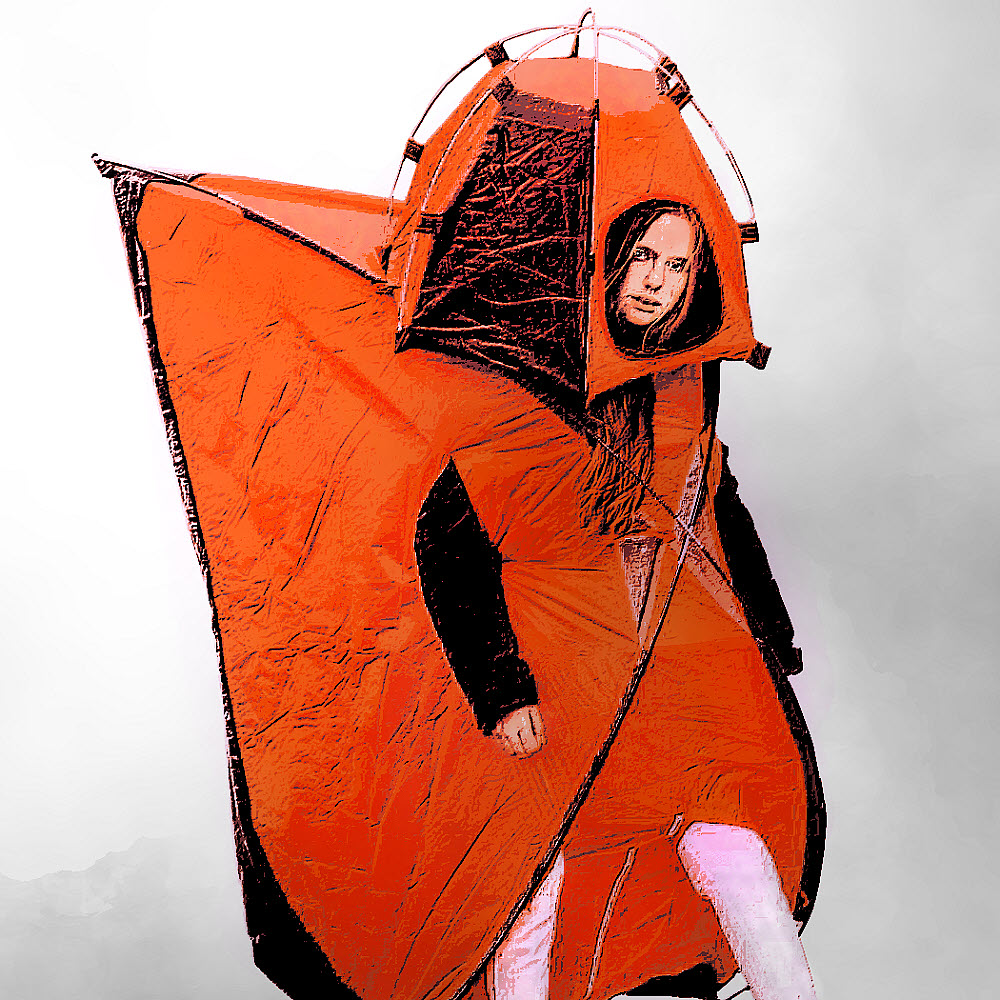
The future has arrived. (Illustration based on the work of Clifford Jago).
So when was the last time you used an elevator driven around by a human? By a human whose job it was to operate the thing. Never, maybe? Never? Do you even have trouble with the concept? I don't.
I remember when. Really.
I has been decades since the last time, and that was when I was in high school, which was a while back, but I do remember, and though that system was hardly ever used even then, it wasn't completely unusual when I was still young to walk into an elevator car and tell the operator which floor you wanted to end up on.
Yes, things have changed, and it's not letting up. (By the way, I was around 10 by the time we got dials on our telephones and could make our own calls without the help of the other kind of operator. I also remember life before television, which was indeed better in some ways.)
I started thinking about this sort of thing last night after seeing the beginnings of a discussion among van dwellers about what self-driving vehicles would be like. Some people thought they'd be nifty, some were afraid, and some doubted that there would ever be such a development. I disagree, with all of them.
We won't know what the future is like until we get there, and when we do get there we won't realize that that's where we were headed. Things will happen but until they do, no one really knows in detail what we'll end up with or how things will have changed.
What we do know is that things will change, and it's like elevators all over again.
First there was muscle power, then combustion engines, then electric motors, and then they eliminated the drivers. So think — when was the last time you took your own elevator to a multi-storey building? When was the last time you even owned an elevator?
Have you even heard of such a thing as owning an elevator? No. You go somewhere, get inside something, push a button, and go back to daydreaming. Then you arrive at your destination and that's it. It's even free.
How about cars then? Are electric cars far off in the future because there's no way to get electricity out where you're going? Nope. Electricity is available in more places than gasoline, let alone diesel, right now. Electricity is everywhere. High-voltage, high-amperage connections need to be installed in thousands of locations for electric vehicles to be practical, but there's no trick to that. It's only a matter of doing it powered by a feedback loop of demand and supply. It will happen.
Electric vehicles are simpler and cheaper to:
- Design
- Manufacture
- Operate
- Maintain
- Repair
That part is inevitable. So is the rest.
Electric vehicles will make self-driving vehicles possible, and machine intelligence will make them happen. We'll live in a different world by then.
Two tidal waves will sneak up and sweep us away. The electric vehicle wave will be the first.
Electric vehicles are already flowing into our lives but we hardly notice because they are still expensive, and imperfect, and rare. Look up in a few years and they'll be everywhere. See the 5th Avenue link below for a view of history. No one will be able to imagine how or why anyone put up with combustion-engine vehicles, composed of hundreds of moving parts, having a constant need to be serviced, requiring toxic and explosive fuels, and emitting even more toxins as exhaust. Just as no one now can imagine how or why people once put up with whole cities full of horse manure and flies.
Combustion-engine vehicles will first become impossible to sell, and then impossible to buy, for good reason. Electric vehicles will do everything better, cheaper, and more simply.
When machine learning becomes adequate, and after machines prove they can do the job, which they will, they will steadily take over the work of driving. Because electric vehicles are already computers on wheels, the navigation and control systems will virtually drop right in. Before long, human-driven vehicles will become impossible to sell, then impossible to buy, and then illegal because it will be recognized that it is far too dangerous to let humans remain in charge. And besides, insurance won't be available. And no one will want the expense of actually owning a vehicle. And it will be too much bother, like taking your own elevator along when you go downtown and want to get to the 37th floor. What?
This makes me wonder what all those van dwellers out there will do. Can't afford/don't want to live in an apartment, won't be able to just drive around the country and park in the woods here and there any more. Then what?
And backpackers, not to mention other rural people — what about them? It'll be hard (probably) to summon a car to drive you around when you're 50 miles out, somewhere, but mostly nowhere, and you have to get elsewhere.
It's certain that:
- Things will be radically different than they are now, and
- Things will work, even though they'll work differently than now
It's likely that:
- A lot of things will be easier than they are now
- Most things will be pre-programmed
- Life will be less spontaneous
- Epiphanies will go extinct
When everything becomes possible, everything becomes ordinary, and that "illuminating realization or discovery, often resulting in a personal feeling of elation, awe, or wonder" will be reduced to a blinking light reminding you to either put another coin in the slot or get the hell out of the car.
Nowadays, right now, it looks like we're seeing some other things fade away. Because population continues to grow, and we are all getting relatively richer in capabilities if not in actual coinage, there are more people "getting out there" and doing things. If it's not hard to get "there", and is no longer awkward and dangerous once you are there, then "there" becomes ordinary. The backcountry becomes another city park.
Need to go somewhere? Query the internet, download an app, read some blog posts, see what your Facebook "friends" think. Need stuff? Click on those handy affiliate links, peruse eBay, order shiny things from Amazon. Get news of somebody doing something? Add it to your "bucket list" and do a "me too", or formulate a plan to be faster, louder, more outrageous, and gain more followers by going crazy on YouTube. Start your own channel. Shoot for a world record — maybe the most selfies in the most dangerous places done in the least amount of time, or something.
Not like the olden days.
No, not like the olden days.
I was in my 30s before I made my first backpacking trip. You couldn't find a tent under six pounds (2.7 kg, whatever "kg" were supposed to be). My first pack weighed four pounds, 14 ounces (2.2 kg) all by itself. Boots were big and heavy and leather. Waterproof/breathable promised salvation and was still so new that it wasn't yet considered a joke. The Svea 123R, whose roots go back over a century, was the height of liquid-fueled stove technology. Frostline Kits were still being sewn in the thousands.
Not all that many people did, but if you wanted something, needed something, and it wasn't out there, you made it. You could. You figured "Why the hell not?"
Along around 2000, some ideas began circulating and some new technologies became available. Silicone-coated nylon was one of them. It promoted huge changes. People went nuts, and internetted everything. Sudden experts appeared everywhere. You know the saying, "When the seeker is ready the guru appears." Like that. Everybody had ideas for what you could do with simple, ordinary materials, some ingenuity, and time. It seemed like you could make anything you needed, if you could imagine it, like stoves from used pop cans.
Odd little web sites popped up everywhere. Every week or so plans for some previously impossible thing, mostly things you had never even thought about at all, got published, and then right after that, someone else published their own directions for making an improved version that cost nothing and weighed less.
Gone now, most of it. Lots of ideas have been incorporated into commercial products, most of which are OK, some of which are OK+, and some of which are not anything but still cost money. The watch-phrase is "Buy it and try it", and never be happy any more, because if you set a world record for Fastest Known Time run-walking the Pacific Crest Trail, then someone else will do better next week and you'll be just another random, washed-up loser again. And if you buy the lightest, most experimental, trickiest whatchamacallit today, then tomorrow, if it hasn't fallen apart already, it will be replaced with the Super Double Plus Good Most Trickiest Thing-A-Ma-Bob Ever, and not only will you be a loser once again but you'll be out all that money and people will keep laughing because you're so lame and carry 0.75 grams more than they do.
So maybe when things were harder and slower and backpacking was something you did because it was interesting and not a competitive sport, maybe in a way it was sort of better as well, no?
Some web sites of the Ancients
Wings: The home-made stove archives
Other relevant stuff
The future of photography is code
Ride transit to the trails with Trailhead Direct
Comments? Send email to sosayseff@gmail.com
See if that helps.









